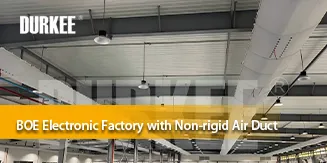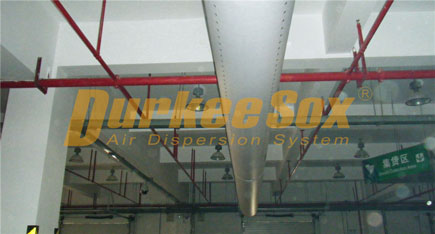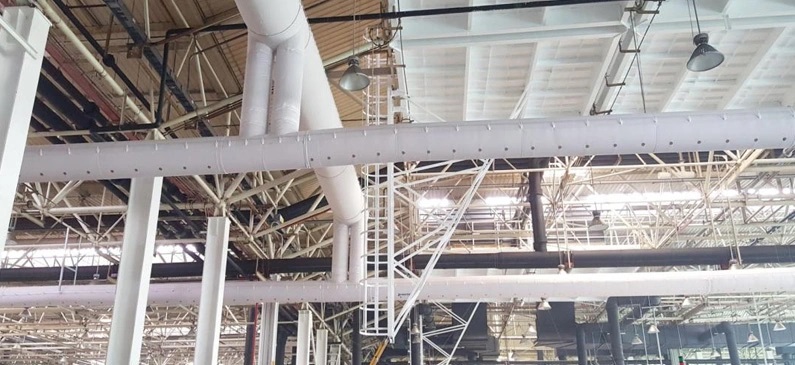 BOE Vietnam Factory: Non-rigid Air Duct Solutions for Electronic Industry
BOE Vietnam Factory: Non-rigid Air Duct Solutions for Electronic Industry
 Why Fabric Air Ducts Are the Preferred Choice for Ventilation in Large Spaces
Why Fabric Air Ducts Are the Preferred Choice for Ventilation in Large Spaces
 The Difference Between Non-Rigid Air Ducts and Rigid Ductwork
The Difference Between Non-Rigid Air Ducts and Rigid Ductwork
In the development of modern architecture and industrial ventilation systems, fabric duct is rapidly becoming the ideal replacement for traditional metal ducts. As the demand for energy efficiency, environmental protection, comfort, and system flexibility increases, fabric duct, with its lightweight, energy-saving, easy installation, and convenient maintenance advantages, is gradually inciting a technological revolution in the global HVAC (Heating, Ventilation, and Air Conditioning) field.
Fabric duct, also known as fabric air distribution systems, is a flexible air delivery device made from high-performance flame-retardant fiber materials (such as polyester fiber, nano-composite coated fabric, etc.). Compared to traditional rigid metal ducts, fabric duct uses specific structural designs to achieve efficient, uniform, and gentle air distribution. There are mainly two working modes:
Permeation Air Supply: Utilizing the natural microporous structure of the fabric fibers, air evenly "permeates" the surface of the duct, creating a draft-free, low-noise gentle airflow, widely used in spaces requiring high air comfort levels.
Nozzle Air Supply: Pre-set air outlets or slots of different sizes and angles on the fabric duct according to design requirements to achieve directional, long-distance efficient air supply, suitable for large spaces such as factories, gymnasiums, and warehouses.
Compared to traditional ventilation systems, fabric duct demonstrates excellent performance and practical value in multiple aspects:
Lightweight Design
The weight of fabric duct is only about 1/40 of that of metal ducts of the same specifications, significantly reducing the building load.
Flexible materials support foldable transportation, on-site installation without welding or heavy brackets, enabling quick assembly and saving more than 50% of the construction period.
Energy Efficiency
Fabric duct has an extremely low inner surface friction coefficient, effectively reducing fan resistance and energy consumption, with energy savings up to 15%-30%.
Even air distribution avoids thermal imbalance, improves air conditioning system efficiency, and significantly reduces energy loss.
Hygiene and Environmental Protection
Most fabric duct features antibacterial, mildew-proof, and anti-static functions, making it especially suitable for scenarios with stringent air quality requirements such as food production, pharmaceuticals, and hospitals.
Materials are recyclable, eco-friendly, and effectively reduce construction waste and subsequent processing costs.
Flexible Customization
Fabric duct can be designed into various shapes such as circular, semicircular, and rectangular according to different architectural spaces. It can also be customized in various colors and prints to meet the aesthetic and functional needs of spaces like malls, exhibition halls, and gyms.
Whether for new projects or retrofitting existing systems, fabric duct can be easily integrated, showing strong compatibility.
Easy Maintenance
The surface of fabric duct is stain-resistant, and daily cleaning only requires wiping or machine washing, making maintenance convenient and saving labor costs.
No need for anti-corrosion treatment, not prone to rust or deformation, with a normal service life of over 15 years, making it truly worry-free and durable.
As the future direction of ventilation systems, fabric duct not only meets the multifaceted needs of modern buildings for energy efficiency, environmental protection, aesthetics, and efficiency but also injects new vitality into HVAC systems with its flexible adaptability and low maintenance costs. Whether for industrial plants, commercial spaces, or public environments, fabric duct is your ideal choice for constructing green and efficient ventilation environments.